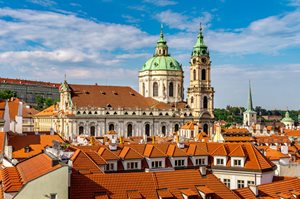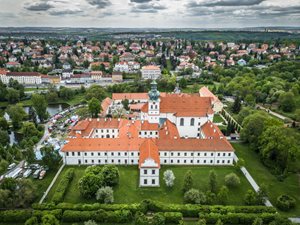The architect that changed the face of many central European cities was born 330 years ago. He designed at the time of high baroque and there are about 200 of his buildings in the Czech Republic. Many of them are gems of baroque architecture that are even referred to in art history books. Come join us on a journey to the past!
Who Was Dientzenhofer?
 Kilian Ignaz Dientzenhofer was born in Prague on 1 September 1689 as the fifth son of builder Christoph Dientzenhofer. He studied philosophy and mathematics at a grammar school in Malá Strana. He learned architecture from his father and then set off abroad in search of experience. At that time, sons in rich families used to travel for a year or two and Kilian’s father let him study all over Europe for eight years. He had the opportunity to explore the works of baroque masters. He lived in Vienna, Venice, Milan, Florence, Rome and even Naples. In 1715, he returned to Prague and worked on several projects with his father. Later, he even completed some of his father’s buildings on his own. He married twice and had eighteen children. At the end of his life, he worked with his son-in-law, Anselmo Lurago, who finished his buildings after his death. He died in Prague on 12 December 1751 and he is buried at the cemetery in Malá Strana. Besides the ornamental religious buildings, he also designed buildings for the countryside. It is interesting that the folk artists transferred the most important elements of his work all the way to the 19th century: we call this style country baroque. The most famous country baroque houses can be found in the village of Holašovice in South Bohemia, listed by UNESCO.
Kilian Ignaz Dientzenhofer was born in Prague on 1 September 1689 as the fifth son of builder Christoph Dientzenhofer. He studied philosophy and mathematics at a grammar school in Malá Strana. He learned architecture from his father and then set off abroad in search of experience. At that time, sons in rich families used to travel for a year or two and Kilian’s father let him study all over Europe for eight years. He had the opportunity to explore the works of baroque masters. He lived in Vienna, Venice, Milan, Florence, Rome and even Naples. In 1715, he returned to Prague and worked on several projects with his father. Later, he even completed some of his father’s buildings on his own. He married twice and had eighteen children. At the end of his life, he worked with his son-in-law, Anselmo Lurago, who finished his buildings after his death. He died in Prague on 12 December 1751 and he is buried at the cemetery in Malá Strana. Besides the ornamental religious buildings, he also designed buildings for the countryside. It is interesting that the folk artists transferred the most important elements of his work all the way to the 19th century: we call this style country baroque. The most famous country baroque houses can be found in the village of Holašovice in South Bohemia, listed by UNESCO. Baroque Churches – Iconic Prague Buildings
St. Nicholas Church at Malá Strana in Prague is probably the most famous building designed by Kilian Ignaz Dientzenhofer. It is also his longest project, or we could even say his life’s work. He started working on it when he was an apprentice; the church was his father’s major work, and he returned to it later, after years spent on the road. This church is one of the foremost baroque buildings in Europe and it is often called the most beautiful Czech baroque building. Its grandiose cupola and the spire are an inseparable part of the panorama of Prague Castle. Also, climbing up the bell tower is an experience: there is an impressive view of the red roofs of Prague and the meandering Vltava River. When you visit the church, take notice of the organ: Wolfgang Amadeus Mozart used to play this instrument. Kilian Ignaz was in charge of the construction of other Prague churches, for example, the Basilica of St. Margaret at the Břevnov Monastery, the oldest monastery in Bohemia, founded in 993. The local monks will be happy to give you a guided tour of the monastery, including the church, on the weekend. Other Prague buildings include the Loreta in Hradčany, Invalidovna in Karlín, a part of Klementinum, or the St. Nicholas Church in the Old Town. He built his own villa in Smíchov for his family, now called Portheimka, where the Museum of Contemporary Glass Art now resides.
Kilian Ignaz was in charge of the construction of other Prague churches, for example, the Basilica of St. Margaret at the Břevnov Monastery, the oldest monastery in Bohemia, founded in 993. The local monks will be happy to give you a guided tour of the monastery, including the church, on the weekend. Other Prague buildings include the Loreta in Hradčany, Invalidovna in Karlín, a part of Klementinum, or the St. Nicholas Church in the Old Town. He built his own villa in Smíchov for his family, now called Portheimka, where the Museum of Contemporary Glass Art now resides. Broumov Region – the Land of Baroque Churches
The Benedictine Order that commissioned the construction of the Church of St. Margaret in Prague from Dientzenhofer was a generous client and they prepared several monumental orders for Kilian Ignaz over the course of time. Together with the Břevnov Monastery, he also reconstructed the Broumov Monastery in East Bohemia and he also worked on the nearby monastery in Police nad Metují. In addition, several village churches near Broumov were being built and reconstructed – in Božanov, Heřmánkovice, Vižňov, Janovičky and other villages. And each church is different. They say that Kilian Ignaz never did the same thing twice and that he never copied his old time-tested templates. Each church has a slightly different ground plan, such as a star or the Greek cross. After almost three centuries, his creativity and artistic work seem almost inexhaustible!And There Is Much More!
 If you find the works of the baroque master interesting, you can follow in his footsteps and visit other buildings as well. You can start in Přeštice, a small town near Plzeň in West Bohemia. The architectonical design of the church, its interior decoration as well as its placement in the landscape make it one of the best Czech baroque sites outside Prague. Within a stone’s throw, there is Plasy with the former Cistercian monastery. The monastery was built by several architects and Kilian Ignaz Dientzenhofer also influenced its final look when he completed the convent building. The monastery is also interesting thanks to the fact that the whole building is standing on oak foundations that have been conserved for centuries by the high level of underground water. Let’s stay in West Bohemia for a bit longer: Dientzenhofer also designed the convent of the Kladruby Monastery, where a lot of people go to admire the late baroque architecture, including the unique basilica designed by Jan Santini Aichel. The central Bohemian town of Kutná Hora contains another gem by Dientzenhofer – the cloister with a church for the Ursuline Order. Today, the premises are used as the Episcopal Grammar School. And southwest of Prague, also in Central Bohemia, there is another trace – in the town of Sázava, in one of the oldest monasteries in the Czech Republic, he was in charge of the construction of the convent of the former Benedictine Monastery.
If you find the works of the baroque master interesting, you can follow in his footsteps and visit other buildings as well. You can start in Přeštice, a small town near Plzeň in West Bohemia. The architectonical design of the church, its interior decoration as well as its placement in the landscape make it one of the best Czech baroque sites outside Prague. Within a stone’s throw, there is Plasy with the former Cistercian monastery. The monastery was built by several architects and Kilian Ignaz Dientzenhofer also influenced its final look when he completed the convent building. The monastery is also interesting thanks to the fact that the whole building is standing on oak foundations that have been conserved for centuries by the high level of underground water. Let’s stay in West Bohemia for a bit longer: Dientzenhofer also designed the convent of the Kladruby Monastery, where a lot of people go to admire the late baroque architecture, including the unique basilica designed by Jan Santini Aichel. The central Bohemian town of Kutná Hora contains another gem by Dientzenhofer – the cloister with a church for the Ursuline Order. Today, the premises are used as the Episcopal Grammar School. And southwest of Prague, also in Central Bohemia, there is another trace – in the town of Sázava, in one of the oldest monasteries in the Czech Republic, he was in charge of the construction of the convent of the former Benedictine Monastery. 










